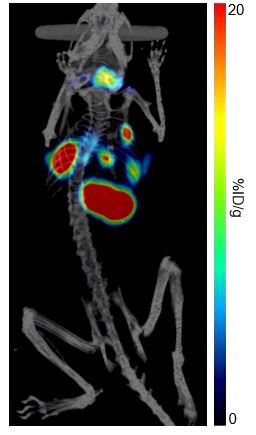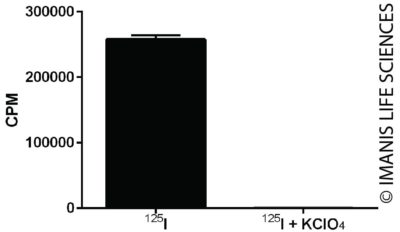LL/2-mNIS (monoclonal)
| Species | Mouse |
| Cell Type | Lewis Lung Carcinoma |
| Transgene | Mouse sodium iodide symporter (mNIS) |
| Selection Gene | Not applicable |
-
Description
LL/2-mNIS is a monoclonal population of the Lewis lung carcinoma cell line LL/2 (ATCC® CRL-1642™). To achieve stable reporter expression in the monoclonal population, parental LL/2 cells were transduced with LV-mNIS (LV008) and expanded from a single cell. LV-mNIS encodes the mouse sodium iodide symporter (mNIS) cDNA under the spleen focus-forming virus (SFFV) promoter.
*The ATCC trademark and trade name and any and all ATCC catalog numbers are trademarks of the American Type Culture Collection.
This cell line has been tested for mycoplasma contamination and is certified mycoplasma free.
The parental LL/2 cell line has been authenticated and certified free of interspecies cross contamination by short tandem repeat (STR) profiling with 9 STR loci.
-
Characterization
In Vivo Imaging
 Immunocompetent syngeneic C57BL/6 mice were injected intraveneously with 1 x 106 LL/2-mNIS (CL114) cells and PET/CT imaging using [18F]-tetrafluoroborate was performed after 27 days.
Immunocompetent syngeneic C57BL/6 mice were injected intraveneously with 1 x 106 LL/2-mNIS (CL114) cells and PET/CT imaging using [18F]-tetrafluoroborate was performed after 27 days.Morphology
 Low and high density cell morphology (200x)
Low and high density cell morphology (200x)NIS Expression
 Cells were incubated with I-125 for one hour in the presence or absence of KClO4, an inhibitor of iodine uptake. Radioiodine concentrated within the cells was measured with a gamma counter.
Cells were incubated with I-125 for one hour in the presence or absence of KClO4, an inhibitor of iodine uptake. Radioiodine concentrated within the cells was measured with a gamma counter. -
Growth Conditions
Complete Growth Medium: DMEM supplemented with 10% FBS and 1X Penicillin/Streptomycin.
These cells should be grown in the indicated medium and passaged when they reach confluency. For routine passaging, cells are recommended to be split at a 1:10 ratio every 3-4 days.
-
Usage Information
These cells are suitable for in vitro and in vivo experimentation.
LL/2 cells form tumors and lung metastases post implantation into syngenic C57BL mice.1,2
The NIS transgene facilitates high resolution, 3D SPECT/PET imaging of implanted cells. NIS is not immunogenic and is therefore suitable for longitudinal imaging studies in a syngenic model.
The cells can be amplified in vitro and used to generate additional frozen stocks. Cryopreservation of low passage stocks is recommended. Frozen stocks should be preserved in a designated cryopreservation medium.
These cells were generated via lentiviral vector transduction. The lentiviral vector used for transduction was a self-inactivating (SIN) vector in which the viral enhancer and promoter have been deleted. Transcription inactivation of the LTR in the SIN provirus increases biosafety by preventing mobilization by replication competent viruses and enables regulated expression of the genes from the internal promoters without cis-acting effects of the LTR3. Nevertheless, all work with these cells should be performed under biosafety-level 2 (BSL2) conditions by trained personnel. Institutional requirements may permit handling of these cells under BSL1 conditions if certain criteria are met.
References:
1Bertram et al. Cancer Letters. 1980. 11:63-73.
2Takeda et al. (2015) Blood 118: 464-472.
3Miyoshi et al. J Virol 1998. 72:8150-8157. -
Datasheet/COA
Lot Number CL-IM121